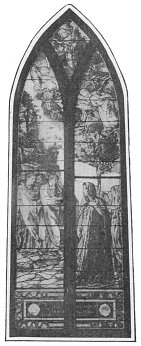
Up: Glassmaking

Stained Glass
12 of 29
|
|
| |

In the Metropolitan Museum
"EVANGELIST"
From the Abbey of Flavigny, near
Nancy, France. Designed and executed by
Valentin Bousch (1531), Flemish school.
|
of Gothic architecture, so painters did likewise for the great openings
of the carved stone windows of the interior by painting in gray on glass
of pearly white the picture of those same niches to enshrine their saints
in the windows. Among the first of English cathedrals to evolve this
distinctly new type of window, both as regards the stone work and
the glass filling the openings, was the Cathedral of Gloucester.
Here we may still see the original glass made for the great east window of

Decorative Glass Studios, Inc.
"THE THREE MARYS
AT THE TOMB"
By John La Farge
In the Church of the
Ascension, New York
|
the choir pretty much as it was placed by
the Benedictine monks who designed
it. Having originated in this choir the new
English type of architecture later
known as the "perpendicular," the builders also set about creating a new
design for the windows corresponding to
the lofty height of the interior they were meant to decorate. This they
did by painting on the glass above the canopied niches tall spires simulating
stone work and reaching far above the figures placed beneath them.
So we find it was the lack of
sunshine in clear, strong floods of light as known in southern countries
that early changed the use of strong, deep color to paler tones in the
windows of English churches.
Special Features of Flemish Glass
The low countries during the late fifteenth
and early sixteenth centuries developed the art of painting on glass
in a manner quite different from the early work we have considered in
France and England. The Flemish master glass workers are credited with
the invention of the silver stain so much used on the halos, heads and
embroidered garments of the figures, as well as on the pinnacles of
architecture framing the groups.
The most important invention, however, was the
development of "flashed" glass, or doubled glass
having a core of white with red, blue or yellow on one side of the pane and
|
|